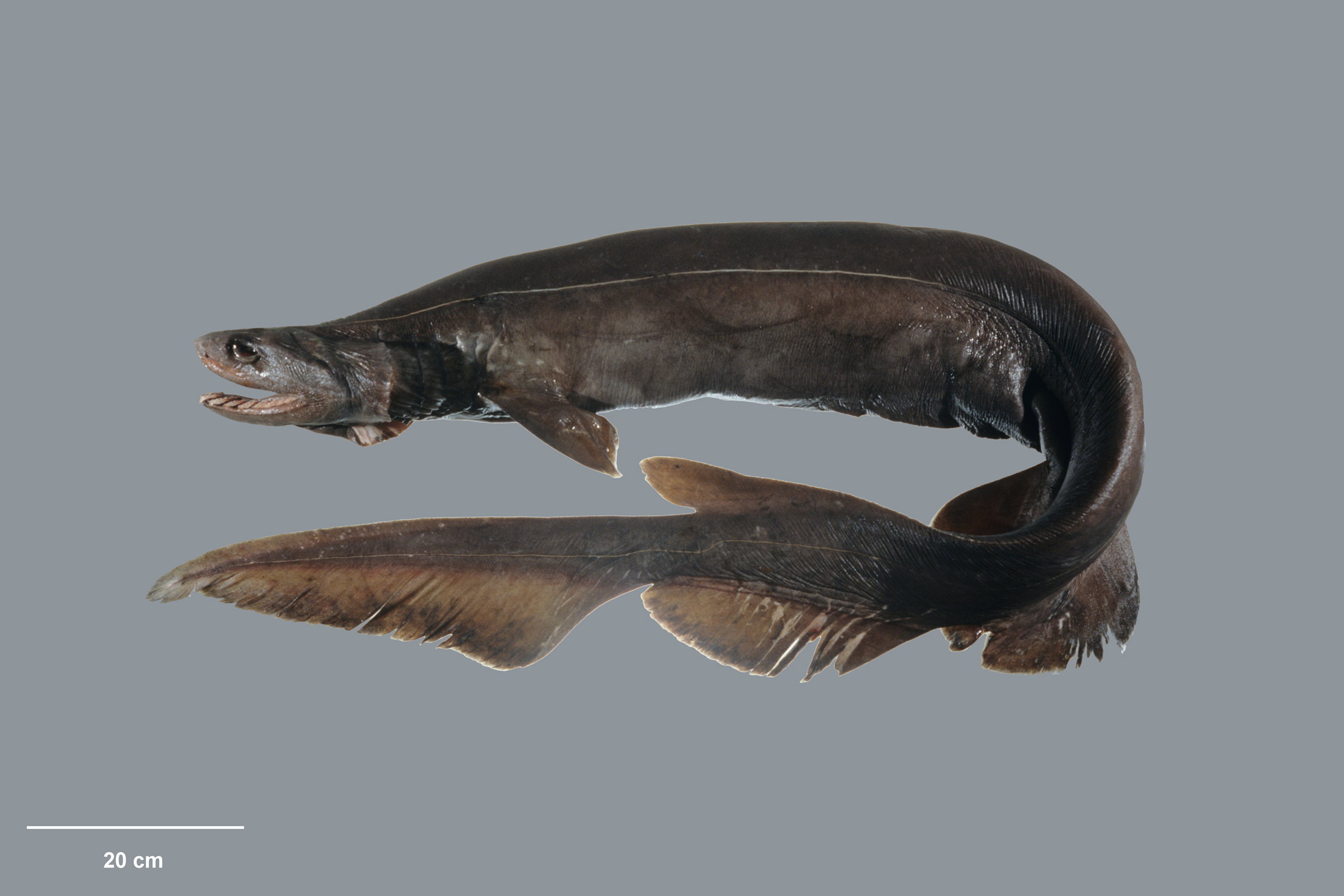Frill Shark, Chlamydoselachus anguineus Garman 1884

A Frill Shark, Chlamydoselachus anguineus, from a seamount on the Louisville Ridge, northeast of the Chatham Rise, January 1996, NMNZ P.033463. Source: Museum of New Zealand, Te Papa Tongarewa. License: CC by Attribution-NonCommercial-NoDerivatives
Video of a Frill Shark swimming
VIDEO of a Frill Shark swimming just above the bottom in 950 metres off South Carolina (USA).
VIDEO of a female Frill Shark caught off Awashima Port in Shizuoka, southwest of Tokyo. The shark was transferred to the Awashima Marine Park, but only lived for a few hours.
Frill Shark, Chlamydoselachus anguineus Garman 1884
More Info
|
Distribution |
Benthopelagic on the continental slope in Australia, from off Sydney (New South Wales) to off southern and western Tasmania in depths of 200-1200 metres. Also on rises and ridges in the Tasman Sea, including the Lord Howe Rise. Elsewhere, the species is patchily distributed in the Atlantic and Pacific Oceans, occurring on the outer continental and insular shelves, and upper continental slopes. The Frill Shark occurs as depths of 20-1500 m, typically at 500-1,000 m. |
|
Features |
Vertebrae: 146-171. Body eel-like with 6 gill slits, the lower ends of the first gill slits connected to each other across throat; mouth terminal with narrow tricuspid teeth in jaws. Dorsal fin single, small, lobe-like, originating far back on body; anal fin larger than dorsal fin; pectoral fins small, paddle-shaped; caudal fin with a weak ventral lobe and no subterminal notch. |
|
Size |
Females may grow to a total length (TL) of almost 2 metres. |
|
Colour |
Dark chocolate brown above, similar or slightly paler below. |
|
Feeding |
Feeds mostly on other deep-water sharks, bony fishes and deepwater squid. With its large mouth, the species can consume relatively large prey. |
|
Biology |
Little is known of the biology of this rare deep-water shark. Size at maturity is estimated at 92–163 cm TL for males, and 130–135 cm TL for females. Reproduction is aplacental viviparous (ovoviviparous) with the young developing from eggs and hatching inside the uterus - where they are nourished by large uterine eggs. Females produce 2-15 pups per litter, born at 39-60 cm TL. Frill Sharks are thought to have a gestation period of more than one year. |
|
Fisheries |
Although not targeted, the Frill Shark is occasionally taken as bycatch in deep-water commercial fisheries. |
|
Conservation |
|
|
Similar Species |
|
|
Species Citation |
Chlamydoselachus anguineus Garman 1884, Bulletin of the Essex Institute 16: 447, figs. Type locality: Sea of Sagami, Japan. |
|
Author |
Bray, D.J. 2017 |
|
Resources |
Frill Shark, Chlamydoselachus anguineus Garman 1884
References
- Barnett, A., Braccini, J.M., Awruch, C.A. & Ebert, D.A. 2012. An overview on the role of Hexanchiformes in marine ecosystems: biology, ecology and conservation status of a primitive order of modern shark. Journal of Fish Biology 80: 966–990.
- Bass, A.J. 1979. Records of little-known sharks from Australian waters. Proceedings of the Linnean Society of New South Wales 103(4): 247-254 figs 1-5 [1978]
- Compagno, L.J.V. 1984. FAO Species Catalogue. Sharks of the World. An annotated and illustrated catalogue of shark species known to date. Hexanchiformes to Lamniformes. FAO Fisheries Synopsis No. 125. Rome : FAO Vol. 4(1) pp. 1-249.
- Compagno, L.J.V., Dando, M. & Fowler, S. 2005. A Field Guide to the Sharks of the World. London : Collins 368 pp.
- Daley, R.K., Stevens, J.D., Last, P.R. & Yearsley, G.K. 2002. Field Guide to Australian Sharks & Rays. Hobart : CSIRO Marine Research 84 pp.
- Ebert, D.A. & Compagno, L.J.V. 2009. Chlamydoselachus africana, a new species of frilled shark from southern Africa (Chondrichthyes, Hexanchiiformes, Chlamydoselachidae). Zootaxa 2173: 1-18.
- Garman, S. 1884. An extraordinary shark. Bulletin of the Essex Institute 16: 47-55 1 fig. Pdf at BHL
- Gudger, E.W. & Smith, B.G. 1933. The natural history of the frilled shark Chlamydoselachus anguineus (pp. 245–319). In: E.W. Gudger (ed.). Bashford Dean Memorial Volume on Archaic Fishes. American Museum of Natural History, New York.
- IUCN SSC Shark Specialist Group. Specialist Group website. Available at: http://www.iucnssg.org/.
- Kubota, T., Shiobara, Y. and Kubodera, T. 1991. Food habits of the frilled shark Chlamydoselachus anguineus collected from Suruga Bay, central Japan. Bulletin of the Japanese Society of Scientific Fisheries. 57(1): 15–20.
- Kukueva, E.I. & Pavlov, P.V. 2008. The first case of mass catch of a rare Frill Shark Chlamydoselachus anguineus over a seamount of the Mid-Atlantic Ridge. Journal of Ichthyology 48(8): 676–678.
- Last, P.R. & Stevens, J.D. 1994. Sharks and Rays of Australia. Canberra : CSIRO Australia 513 pp. 84 pls.
- Last, P.R. & Stevens, J.D. 2009. Sharks and Rays of Australia. Collingwood : CSIRO Publishing Australia 2, 550 pp.
- Nakaya, K. & Bass, A.J. 1978. The frill shark Chlamydoselachus anguineus in New Zealand seas. New Zealand Journal of Marine and Freshwater Research 12(4): 397-398
- Smart, J.J., Paul, L.J. & Fowler, S.L. 2016. Chlamydoselachus anguineus. The IUCN Red List of Threatened Species 2016: e.T41794A68617785. http://dx.doi.org/10.2305/IUCN.UK.2016-1.RLTS.T41794A68617785.en. Downloaded on 26 July 2017.
- Smith, J.L.B. 1967. The lizard shark Chlamydoselachus anguineus Garman, in South Africa. Occasional Papers. Department of Ichthyology, Rhodes University 10: 105-114 fig. 1 pls 19-23
- Stead, D.G. 1963. Sharks and Rays of Australian Seas. Sydney : Angus & Robertson 211 pp. 63 figs.
- Stevens, J. & P.R. Last in Paxton, J.R. & W.N. Eschmeyer (eds). 1994. Encyclopedia of Fishes. Sydney: New South Wales University Press. 240pp.
- Tanaka, S., Shiobara, Y., Hioki, S., Abe, H., Nishi, G., Yano, K. and Suzuki, K. 1990. The reproductive biology of the frilled shark, Chlamydoselachus anguineus, from Suruga Bay, Japan. Japanese Journal of Ichthyology 37(3): 273–291.
- White, W. 2008. Shark Families Heterodontidae to Pristiophoridae. pp. 32-100 in Gomon. M.F., Bray, D.J. & Kuiter, R.H (eds). Fishes of Australia's Southern Coast. Sydney : Reed New Holland 928 pp.








